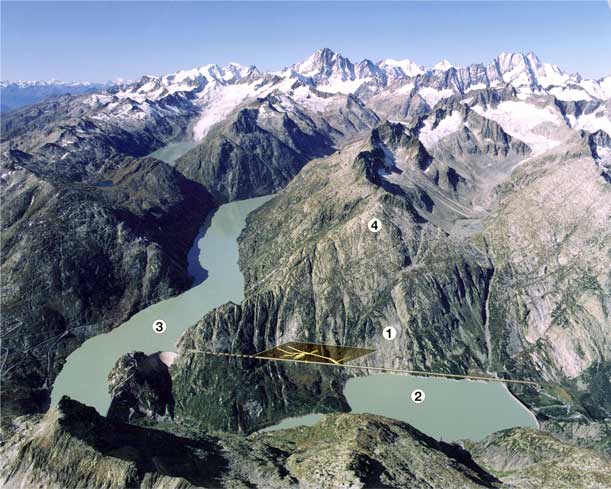This five-day course is presented as a collaboration between the GTC (Grimsel Training Centre) and NTS (Nuclear Training Solutions). The course provides a basic background in deep geological disposal for project managers and scientists, implementing and regulatory agencies, geosciences, environmental and engineering companies involved with site investigation, safety assessment, repository design and the construction of underground facilities. The course will take place in the GTC, part of Nagra’s Grimsel Test Site, situated in the stunning Bernese Alps in south-central Switzerland.
 Location of the Grimsel Test Site (GTS) in Switzerland - (1) Grimsel Test Site, (2) Rätrichsbodensee, (3) Grimselsee and (4) Juchlistock
Location of the Grimsel Test Site (GTS) in Switzerland - (1) Grimsel Test Site, (2) Rätrichsbodensee, (3) Grimselsee and (4) Juchlistock
This is an extended and updated version of NTS’ regular ‘Fundamentals’ course which ranges across all key aspects and topical issues concerned with managing a national geological disposal programme. The extended 2018 course will be taught in the fabulous surroundings of the Grimsel Test Site and will feature an in-depth examination of the past, present and future roles of underground rock laboratories in waste disposal.
|
Time |
Day 1 – 25th June |
Day 2 – 26th June |
Day 3 – 27th June |
Day 4 – 28th June |
Day 5 – 29th June |
|---|---|---|---|---|---|
|
09:00-09:15 10:00 |
Introduction to course |
4b Basics of post-closure performance (PA) and safety assessment (SA) |
7 Building the Safety Case |
12 Retardation of radionuclides in the repository multi-barrier system |
14 Repository construction and operation |
|
1 Nuclear Power – outlook from a global perspective and the relevance of radwaste management – strategies and challenges for the next 150 years |
|||||
|
10:00-10:20 |
break |
break |
break |
break |
break |
|
10:20-11:20 |
2a Waste classification and properties |
5a Repository design |
8 How do we support the safety case (SC)? |
13a The societal dimension of radioactive waste management: stakeholder dialogue |
15 Repository closure, monitoring and retrievability & reversibility (R&R) |
|
11:20-11:40 |
break |
break |
break |
break |
break |
|
11:40-12:40 |
3a Principles of geological disposal |
5b Repository design |
9 Details of the use of natural analogues (NA) in an integrated safety case and challenges for the future |
13b Group exercise in stakeholder dialogue (who are the stakeholders, what is at stake, how do we build a dialogue?) |
16 Introduction to Quality Management Systems |
|
12:40-14:00 |
lunch |
lunch |
lunch |
lunch |
lunch |
|
14:00-1500 |
3b Principles of geological disposal |
6a Site characterisation |
10a The role of underground research facilities 10b The use of URLs in an integrated safety case and challenges for the future – case studies from URL projects
break 11a Visit of Grimsel Test Site
11b from subsurface to surface - geological excursion back to the valley Finish ca. 17:30 |
13b Group exercise continues
ca. 15:30 |
17a Group discussion: structuring a national radioactive waste management programme |
|
15:00-15:20 |
break |
break |
break |
||
|
15:20-16:20 |
4a Basics of post-closure performance and safety assessment |
6b Site characterisation |
17b Group discussion |
||
|
16:20-16:50 |
Coffee break and wrap-up discussion |
Coffee break and wrap-up discussion |
break |
||
|
|
|
|
18 Course wrap-up and presentation of course certificates |
If you wish to discuss your potential participation further, please contact any of the course co-directors:
Dr. Russell Alexander (NTS: This email address is being protected from spambots. You need JavaScript enabled to view it.)
Dr. Ingo Blechschmidt (GTC: This email address is being protected from spambots. You need JavaScript enabled to view it.)
Dr. Andrew Martin (GTC: This email address is being protected from spambots. You need JavaScript enabled to view it.)
NOTE : There will be a visit to the Mont Terri URL on Saturday, 23rd June. If you would like to join us, please tick the appropriate box in the registration form.




